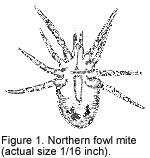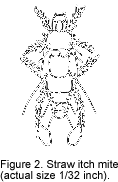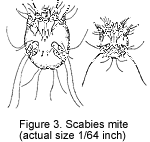Mites that Attack Humans
|
Treatment Options & Useful Web Resources & Forums ... Related News Articles / Videos ... Dealing with Infected Pets |
Different opinions / experiences pertaining to the effectiveness of Pyrethin and Permethrin have been voiced, and relevant information is herewith including. In reviewing the below research article, also keep the following in mind.
- More effective treatments than the above are said to be Tralomethrin, Bifenthrin, Cyfluthrin or Esfenvalerate. It is recommended to vary the type of insecticide spray regularly as mites (as all insects) eventually build up a tolerance towards them.
- Some effective miticides include Spectracide's 'Bug Stop' with Lamba- Cyhalothrin, Bayer's 'Power Force' with Cyfluthrin (concentrate), and Hot Shot's 'Ultra' with Imiprothrin and Esfenvalerate."
Please visit this website for relevant research on treatment options pertainig to Northern Fowl Mites and Chicken Mites. The suggested chemical treatment options vary - maybe because of built-up resistances or varying species.
Mites That Attack Humans1
P. G. Koehler2
University of Florida, Institute of Food and Agricultural Sciences (UF/IFAS)
Mites are small arthropods with two body regions, sucking mouthparts, no antennae, and four pairs of legs as adults. The life cycle of a mite is generally composed of four active stages: egg, larva, nymph, and adult. The life cycle usually requires one to four weeks and may result in huge populations of mites when there are favorable conditions.
Household Mites
Mites are occasionally found in homes and attack humans in the absence of their normal hosts-birds, rodents, or insects. Bites from these mites may be painful and cause severe skin irritation.
 Bird Mites
Bird Mites
The northern fowl mite ( Figure 1 ), tropical fowl mite, and chicken mite are the major bird mite species in Florida. The northern fowl mite is the species most important as a problem to birds in the state. They are accidental pests to humans.
The adult, female, fowl mite lays eggs on the host bird. The eggs hatch in 1-2 days into the six-legged larval stage which does not feed. The larvae molt to the nymphal stage in about eight hours. The nymphs and adults have piercing mouthparts and seek blood meals. The complete life cycle from egg to egg-laying adult can take from five to seven days or longer, depending on the environment.
Bird mites are usually encountered in homes when they migrate from bird nests in eaves, rafters, or gutters. They prefer to feed on fledglings in the nest, but when the young leave the nest, the mites will migrate to other areas in search of a blood meal. Many times infestation of buildings occur when roosts and nests of birds are disrupted or destroyed.
- Topical application of garlic reduces northern fowl mite infestation in laying hens - GP Birrenkott, GE Brockenfelt, JA Greer, and MD Owens
Department of Animal and Veterinary Sciences, Clemson University, South Carolina 29634-0361, USA. [email protected]Northern fowl mites (NFM) are external parasites that can lower egg production and cause anemia and even death in laying hens. An experiment was conducted with New Hampshire Red and Single Comb White Leghorn laying hens. Hens were individually caged and provided a complete laying diet and water ad libitum. Hens were assigned to groups in a way that assured that treatments, within each breed, would be applied to comparable numbers of birds with light and heavy mite infestations. Each hen was sprayed around the vent with either water or 10% garlic juice in water. Spraying continued each week for 3 wk. During the fourth week, each bird was scored for the presence of NFM on its skin and feathers. A small snippet of feathers was removed from below the vent of each hen and placed in a labeled petri dish with a round, white filter paper insert. The NFM content of each dish was scored by two individuals approximately 1 h after sampling. There was no significant difference in the NFM scores for hens based on breed or future treatment. After the birds were treated for 3 wk, there was no significant difference in external NFM scores based on breed. There were significantly fewer NFM on the birds treated with garlic juice compared with controls, based on external and petri dish scoring (P < 0.002 and P < 0.04, respectively). The reduction in external NFM score was also significant (P < 0.004), with controls declining approximately 0.2 units, whereas garlic-treated hens had a 1.8-unit decrease in external NFM score. Topical application of garlic juice may be an effective way to decrease NFM in laying hens. (Ref. http://ps.fass.org/cgi/content/abstract/79/11/1575?)
- Please refer to this webpage for relevant research on efficacies of different treatment options.
 Insect Mites
Insect Mites
The straw itch mite (Figure 2) is the most prevalent insect parasite that also attacks humans. The straw itch mite is an almost invisible mite because of its small size. Infestations from alfalfa, hay, and barley can produce irritation.
The mites are parasitic on the larvae of insects such as the Angoumois grain moth, the wheat jointworm, and furniture beetles. The female mite retains up to 300 eggs in her body, and the immature stages develop to adults inside the female. Upon emerging they search for hosts to parasitize.
The bites of the straw itch mite are located almost entirely on the clothed portions of the body. Dermatitis results from reaction to the bites within twenty-four hours. Humans become infested when they come in contact with straw, grain, or wood. Houses may become infested when the insect hosts of the mites are present.
Rodent Mites
The two most abundant rodent mites in buildings are the tropical rat mite and the house mouse mite. Rodent mites are primarily external parasites of rats and house mice, but they will also feed on humans.
The life cycle of rodent mites is similar to the bird mites. The life cycle usually takes from ten to twelve days.
Rodent mites can cause severe irritation and dermatitis in humans. Areas bitten by mites may remain swollen for several days and leave red spots. Scratching of bites often can result in secondary infection.
Control
Control of household mites is best accomplished by eliminating nests and roosting areas for birds, controlling rodents, or controlling insect hosts. Household mites can be controlled with indoor space sprays and are listed in Table 1 . These products are effective in killing mites but do not prevent reinfestation. Application may need to be repeated in two to three weeks.
Mites often invade structures from crawl spaces or attics. Residual crack and crevice treatments can be used to kill mites as they crawl into rooms. Table 2 lists products labeled as contact products.
Mites sometimes invade structures from perimeter infestations. These mites can be prevented from entering buildings by applying an outdoor barrier treatment. Products labeled for outdoor barrier treatment are listed in Table 3 .
Bites should be treated with antiseptic and a local anesthetic may be applied to ease the irritation. Persons with severe dermatitis caused by mites should consult their physician for treatment.
 Scabies Mites
Scabies Mites
Biology
The scabies mite ( Figure 3 ) or human itch mite burrows into the outer layers of the skin of humans causing human mange or scabies. Different varieties of scabies mites are specific for certain mammals including man, domestic animals, and wild animals.
The female mite makes long burrows in folds of skin. The female lays from forty to fifty eggs in the burrow. The larvae and nymphs develop and burrow in the skin. The total life cycle takes one to three weeks depending on the environment.
Transmission
Scabies mites are transmitted from one person to another by direct contact or also by two persons using one bed. People are most likely to become infested when living in crowded quarters with other people. Dog scabies often can be transmitted to man under ideal conditions.
Symptoms
Persons infested with scabies suffer severe itching. A rash may develop later as the person becomes sensitized to the mites. The rash usually occurs around armpits, the wrists, the waist, and back of the calves. Even though only a few mites may be present, the rash may spread over much of the body.
Control
If scabies mites are suspected, a physician should be consulted for diagnosis and treatment. If dog scabies transmission to man is suspected, a veterinarian should be consulted for treatment of the dog.
House Dust Mites
The house dust mites (floor mites) are increasing in medical significance to humans. The importance of house dust mites is that pieces of the mites in house dust may produce allergic reactions and asthma when inhaled. It is presently estimated that four percent of the human population shows a house dust allergy.
Biology
The adult, female, house dust mite is approximately 1/64 inch long and the males are even smaller. Because of their small size these mites are often overlooked in a house.
The adult female lays about an egg a day for thirty days. The eggs hatch and develop to adults in about one month.
House dust mites feed on the shed skin of humans. It has been estimated that the average person sheds five grams of skin per week. One gram of skin will feed thousands of mites for months.
The house dust mite is found commonly in houses and schools throughout the United States. The most common habitat for the mite is in thick carpeting, heavy curtains, fabric covered furniture, beds and pillows.
Mite Allergy
House dust mites or their fragments, excretory, or secretory products are the most important allergens found in house dust. Asthmatic symptoms after exposure to house dust have long been known and only recently has it been shown that the house dust mites, like pollen, can be the potential producers of allergic responses when inhaled.
Asthmatic patients who go to bed in the bedroom often realize aggravated asthmatic symptoms due to increased exposure to house dust mites. Patients who are hospitalized often dramatically improve due to less exposure.
Control
Frequent changing of bedding and use of non-fibrous bedding will reduce mite populations. Frequent vacuum cleaning and correction of excess humidity problems will aid in mite control. Use vacuums equiped with Hepa filters. Hepa air cleaners and Hepa air filters for air and heating units can help reduce allergen effects.
Remove carpeting where possible. If carpeting cannot be removed, use an appropriate acaricide. Follow the label.
 Table 1. Mite management products labeled for indoor space treatment.*
Table 1. Mite management products labeled for indoor space treatment.*
|
Common Name |
Homeowner Products1 |
Commercial Products1 |
| Prallethrin | PT ULD SPy-300 (C, CH, G)2 | |
| Pyrethrins | Kicker (G)2
PT ULD BP-300 (CH)2 |
|
| Pyrethrins and Others | PT 565 Plus XLO (C, G)2
PT ULD BP-100 (C, CH, D, DF, F, G)2 |
|
| Pyrethrins, PBO | PT P.I. Contract Insecticide (C, G2
PT ULD BP-50 (C, CH, D, G)2 Pyrenone 100 (C, CH, G)2 Synerol Insecticide (C, CH, G)2 |
|
| Pyrethrins, PCO | Pyrenone 50 (C, CH, G)2 | |
| 1 Read label carefully to insure pest, site, and commodity are listed prior to applying product. Some product labels are very restrictive.
2 C = Clover Mites, CH = Cheese Mites, D = Dust Mites, DF = Dried Fruit Mites, F = Flour Mites, G = Grain Mites |
||

 Table 2. Mite management products labeled for crack and crevice or indoor surface treatment.*
Table 2. Mite management products labeled for crack and crevice or indoor surface treatment.*
|
Common Name |
Homeowner Products1 |
Commercial Products1 |
| Boric Acid | PT Perma Dust Pressurized Boric Acid Dust (C)2 | |
| Cyfluthrin | PT Cy-Kick Crack & Crevice Pressurized Residual (C)2
PT Cy-Kick CS Pressurized Crack & Crevice Residual (CH, DF, F, G)2 |
|
| Deltamethrin | DeltaDust (CH, G)2
DeltaGard G (CH, G)2 Suspend SC Insecticide (G)2 |
|
| Lambda Cyhalothrin | PT 221L (C)2 | |
| Prallethrin | PT ULD SPy-300 (C)2 | |
| Pyrethrins | Kicker (G)2
PT Tri-Die Silica & Pyrethrum Dust (C, CH, G)2 PT ULD BP-300 (CH)2 |
|
| Pyrethrins and Others | PT 565 Plus XLO (C, G)2
PT Microcare CS Controlled Release Pyrethrum (C, CH, D, DF, F, G)2 PT Microcare Pressurized Pyrethrum Capsule Suspension (C, CH, DF)2 PT Tri-Die Pressurized Silica & Pyrethrin Dust (C, CH, G)2 PT ULD BP-100 (C, CH, D, DF, F, G)2 |
|
| Pyrethrins, PBO | PT P.I. Contact Insecticide (C, G)2
PT ULD BP-50 (C, CH, D, G)2 Pyrenone 100 (C, CH, G)2 Synerol Insecticide (C, CH, G)2 |
|
| Pyrethrins, PCO | Pyrenone 50 (C, CH, G)2 | |
| Tau-Fluvalinate | Yardex Supplemental Labeling (C)2 | |
| Tralomethrun | Saga WP Insecticide (G)2 | |
| 1 Read label carefully to insure pest, site, and commodity are listed prior to applying product. Some product labels are very restrictive.
2 C = Clover Mites, CH = Cheese Mites, D = Dust Mites, DF = Dried Fruit Mites, F = Flour Mites, G = Grain Mites |
||
 Table 3. Mite management products labeled for outdoor barrier treatment.*
Table 3. Mite management products labeled for outdoor barrier treatment.*
|
Common Name |
Homeowner Products1 |
Commercial Products1 |
| Acephate | PT Orthene Crack & Crevice Pressurized Residual (C)2 | |
| Bifenthrin | Ortho Home Defense Perimeter & Indoor Insect Killer (C)2 | Talstar F Insecticide/Miticide (C)2 |
| Cyfluthrin | Bayer Power Force Multi-Insect Killer Ready-to-Spray (C)2
Bayer Power Force Multi-Insect Killer Ready-to-Use (C)2 |
PT Cy-Kick Crack & Crevice Pressurized Residual (C)2
PT Cy-Kick CS Controlled Release Cyfluthrin (C)2 |
| Deltamethrin | DeltaGard G (C)2 | |
| Lambda Cyhalothrin | PT 221L (C)2 | |
| Permethrin | Ortho Bug-B-Gon Multipurpose Insect Killer Ready-Spray (C)2 | |
| Pyrethrins | PT Tri-Die Silica & Pyrethrum Dust (C)2 | |
| Pyrethrins and Others | PT Microcare CS Controlled Release Pyrethrum (C, D)2
PT Microcare Pressurized Pyrethrum Capsule Suspension (C)2 PT Tri-Die Pressurized Silica & Pyrethrin Dust (C)2 |
|
| Tau-Fluvalinate | Yardex Supplemental Labeling (C)2 | |
| 1 Read label carefully to insure pest, site, and commodity are listed prior to applying product. Some product labels are very restrictive.
2 C = Clover Mites, CH = Cheese Mites, D = Dust Mites, DF = Dried Fruit Mites, F = Flour Mites, G = Grain Mites |
||
Footnotes
1. This document is ENY-218, one of a series of the Entomology and Nematology Department, Florida Cooperative Extension Service, Institute of Food and Agricultural Sciences, University of Florida. Publication date: April 1993. Revised: April 2003. Please visit the EDIS Website at http://edis.ifas.ufl.edu.
2. P. G. Koehler, professor/extension entomologist, Entomology and Nematology Department, Cooperative Extension Service, Institute of Food and Agricultural Sciences, University of Florida, Gainesville, 32611.
The use of trade names in this publication is solely for the purpose of providing specific information. UF/IFAS does not guarantee or warranty the products named, and references to them in this publication does not signify our approval to the exclusion of other products of suitable composition. Use pesticides safely. Read and follow directions on the manufacturer's label.
The Institute of Food and Agricultural Sciences (IFAS) is an Equal Opportunity Institution authorized to provide research, educational information and other services only to individuals and institutions that function with non-discrimination with respect to race, creed, color, religion, age, disability, sex, sexual orientation, marital status, national origin, political opinions or affiliations. For more information on obtaining other extension publications, contact your county Cooperative Extension service.
U.S. Department of Agriculture, Cooperative Extension Service, University of Florida, IFAS, Florida A. & M. University Cooperative Extension Program, and Boards of County Commissioners Cooperating. Larry Arrington, Dean.
Copyright Information
This document is copyrighted by the University of Florida, Institute of Food and Agricultural Sciences (UF/IFAS) for the people of the State of Florida. UF/IFAS retains all rights under all conventions, but permits free reproduction by all agents and offices of the Cooperative Extension Service and the people of the State of Florida. Permission is granted to others to use these materials in part or in full for educational purposes, provided that full credit is given to the UF/IFAS, citing the publication, its source, and date of publication. Original Text.
GreenAndHealthy.Info strives to maintain accurate and up-to-date information; however, mistakes do happen. If you would like to correct or update any of the information, please send us an e-mail. THANK YOU!

